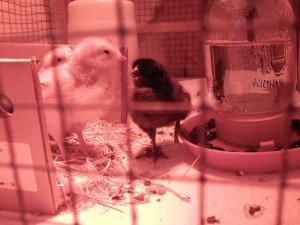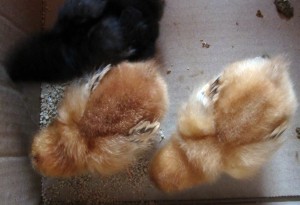Chickens in the sewing room
 Growing up in Keene, ON, I volunteered, and then in university worked, as a costumed interpreter at Lang Pioneer Village.  When I started my job as a student, the museum wasn’t in its heyday – attendance was down, and many of the things I’d loved about the place had fallen by the wayside – the Fitzpatrick herb garden, the wonderful bake oven in the Keene Hotel which produced the best fresh bread I’d ever tasted.*  In addition, rules had changed; they couldn’t produce their own fresh, white, wet cheese or unpasteurized apple cider anymore.  That Summer was rainy and slow, too, and days would pass without a single visitor coming in to my building. So I had plenty of time to poke around.
Growing up in Keene, ON, I volunteered, and then in university worked, as a costumed interpreter at Lang Pioneer Village.  When I started my job as a student, the museum wasn’t in its heyday – attendance was down, and many of the things I’d loved about the place had fallen by the wayside – the Fitzpatrick herb garden, the wonderful bake oven in the Keene Hotel which produced the best fresh bread I’d ever tasted.*  In addition, rules had changed; they couldn’t produce their own fresh, white, wet cheese or unpasteurized apple cider anymore.  That Summer was rainy and slow, too, and days would pass without a single visitor coming in to my building. So I had plenty of time to poke around.
Behind the Keene Hotel was a chicken coop; a pretty sturdy, impressive thing with a fenced-in yard overgrown with vines. Â I idly wished for the days when they kept chickens there, but didn’t pursue it; the new administrators were taking things in hand, and attendance was improving. Â There was less time to poke around and daydream. Â But I think the idea of chickens stayed with me.
A few years ago, I saw a news report about backyard chickens in Toronto; I saw the small backyard and the cozy coop – an Eglu – and the seed of an idea that had laid dormant in my mind burst forth.  But time and money haven’t been plentiful in the past couple of years; I had to wait. As the snow began to recede this year, it occurred to me that the time was probably right to pursue my own little flock.
 So in late March, after doing some reading online, I went down to the local Co-op and ordered 4 chicks from Frey’s Hatchery – two Rhode Island Reds, two Black Stars.  And then, instead of settling down to wait, I fussed over the things I needed to buy.  I read and re-read articles, forums, and posts.  I scrounged for tips.  And I came up with lots of divergent opnions, and no decent guide for my teeny flock.  So I thought I’d write about the process myself, partly to record what I did, partly to help other small-flock owners with their first order of chicks.
So in late March, after doing some reading online, I went down to the local Co-op and ordered 4 chicks from Frey’s Hatchery – two Rhode Island Reds, two Black Stars.  And then, instead of settling down to wait, I fussed over the things I needed to buy.  I read and re-read articles, forums, and posts.  I scrounged for tips.  And I came up with lots of divergent opnions, and no decent guide for my teeny flock.  So I thought I’d write about the process myself, partly to record what I did, partly to help other small-flock owners with their first order of chicks.
Obviously, I’m a total newbie at this, so I can’t say I’m any authority; please be sure to consult widely before taking the plunge yourself.
It is legal?
 In my area, as far as I understand, the bylaws regarding chickens say that you can keep them, as long as they’re pets rather than livestock. Â I think it would be great if the City of Peterborough changed the rules to reflect current mores; in the past, keeping a kitchen garden or livestock was considered ‘common’, and that just isn’t so anymore. Â Provided that people are responsible flock owners, there’s no good reason that you shouldn’t be able to keep laying hens. Â I’m interested in working with other local chicken-keepers to propose to council that they change the bylaws; until that time, my pullets are pets.
In my area, as far as I understand, the bylaws regarding chickens say that you can keep them, as long as they’re pets rather than livestock. Â I think it would be great if the City of Peterborough changed the rules to reflect current mores; in the past, keeping a kitchen garden or livestock was considered ‘common’, and that just isn’t so anymore. Â Provided that people are responsible flock owners, there’s no good reason that you shouldn’t be able to keep laying hens. Â I’m interested in working with other local chicken-keepers to propose to council that they change the bylaws; until that time, my pullets are pets.
Costs
At the scale that I’m working with, this may not be an economical venture in the short-term, especially when you factor in electricity.  With a larger flock, you can recoup some of the costs via farm gate sales of eggs. However, there are a lot of one-time purchases, and if I keep on with keeping chickens, it’s potentially a worthwhile investment. So far, here’s what I’ve spent:
$28.00  Chicks (4 – shipping, taxes, small order fee)
$1.68 Â Chick waterer (the kind you screw on a mason jar)
$1.13 marbles to put in the Chick Waterer so they won’t drown (doesn’t actually seem to be much of a concern)
$12.42 Chicken Feeder (3lb hanging type)
$38.13 Heat lamp, and 175 W bulb, cheap thermometer
$13.49 Chick Starter Feed (25kg bag)
Brooding Pen
 I read about a thousand posts and articles about brooding pens, fretting over the size, etc. Â What I used in the end is a small home-made animal cage that we had kicking around, built of wood and chicken wire, set up in a part of the sewing room that isn’t high-traffic but is high visibility. Â It measures 1’6″x2′, and seems to be more than enough space. Â I’ve lined the bottom with paper towel, underneath which is chicken wire, and then to protect the floor I lay down some newspapers. Â I read somewhere that chicks have an easier time sleeping under a red heat lamp, so chose that colour. Â Now day and night our front window is lit red, which in our neighborhood might easily lead to misunderstandings, so we’ll see!
I read about a thousand posts and articles about brooding pens, fretting over the size, etc. Â What I used in the end is a small home-made animal cage that we had kicking around, built of wood and chicken wire, set up in a part of the sewing room that isn’t high-traffic but is high visibility. Â It measures 1’6″x2′, and seems to be more than enough space. Â I’ve lined the bottom with paper towel, underneath which is chicken wire, and then to protect the floor I lay down some newspapers. Â I read somewhere that chicks have an easier time sleeping under a red heat lamp, so chose that colour. Â Now day and night our front window is lit red, which in our neighborhood might easily lead to misunderstandings, so we’ll see!
Fiddling with the damned heat lamp and thermometer was an exercise in frustration; I switched thermometers and have mostly been adjusting to suit the chicks, rather than the suggested temperature.
The cats were initially fascinated, but are now pretty blasé.
Arrival
 I got a call from the Co-op on April 5 saying that my chicks would be in the next morning between 9am and 10am.  I made my final adjustments to the brooding pen, putting in the feed and the waterer, and adding a teaspoon of sugar to the water, which I’d been told to do the first time to pep them up after the trip. I popped over at lunch on April 6 and picked up the smallest of a pile of cheeping boxes, stopping quickly on my way to the car to take a look.  When I got them home, I turned on the heat lamp, and grabbed each chick one at a time, dipping their beaks in the water to teach them where it is before releasing them. They settled in right away, figuring out where the feed and water was in no time, cheeping softly and walking around the pen.
I got a call from the Co-op on April 5 saying that my chicks would be in the next morning between 9am and 10am.  I made my final adjustments to the brooding pen, putting in the feed and the waterer, and adding a teaspoon of sugar to the water, which I’d been told to do the first time to pep them up after the trip. I popped over at lunch on April 6 and picked up the smallest of a pile of cheeping boxes, stopping quickly on my way to the car to take a look.  When I got them home, I turned on the heat lamp, and grabbed each chick one at a time, dipping their beaks in the water to teach them where it is before releasing them. They settled in right away, figuring out where the feed and water was in no time, cheeping softly and walking around the pen.
 The next day, one of the chicks was emerging as the bully of the group, pecking at the others, and one was missing a patch of feathers; bad signs.  I took a look at our little fuzzy friends, and it turned out that three of them had blocked cloaca, a problem which reoccurred over the next day.  Known in backyard chicken circles as ‘pasty butt’ (a phrase I type reluctantly because it sounds so cutesy), this is the result of diarrhea drying and blocking the orifice that chicks use to eliminate waste, known as the cloaca or vent.  I’ve read that diarrhea in chicks happens as a result of stress or medication, and I tried two complementary cures: first, gently wiping the cloaca with a paper towel and warm water to loosen the dried stool, which took a little patience but wasn’t difficult.  Secondly, I added a teaspoon of plain, unsweetened yoghurt to their feed, mixing it well.
The next day, one of the chicks was emerging as the bully of the group, pecking at the others, and one was missing a patch of feathers; bad signs.  I took a look at our little fuzzy friends, and it turned out that three of them had blocked cloaca, a problem which reoccurred over the next day.  Known in backyard chicken circles as ‘pasty butt’ (a phrase I type reluctantly because it sounds so cutesy), this is the result of diarrhea drying and blocking the orifice that chicks use to eliminate waste, known as the cloaca or vent.  I’ve read that diarrhea in chicks happens as a result of stress or medication, and I tried two complementary cures: first, gently wiping the cloaca with a paper towel and warm water to loosen the dried stool, which took a little patience but wasn’t difficult.  Secondly, I added a teaspoon of plain, unsweetened yoghurt to their feed, mixing it well.
I’ve read that chicks would normally obtain probiotics from pecking at their mother’s droppings, but since these chicks are hatched in an incubator, they have no source of probiotics.  If I’d know this in advance, I probably would have set out some of the yoghurt mash earlier.  In any case, the mash seems to have cleared up the problem; the bully chick, of course, is the one who had no difficulties with diarrhea. We’ll keep doing it every other day for a week or so; the chicks love the mash, so at least they get a bit of a treat with their treatment.
5 days old
 Today my chicks are 5 days old, tentatively named, and thriving. Â They’ve already developed wing and tail feathers and are starting to look like birds rather than chicks, flapping their wings to get away when you try to hold them. Â It’s pretty adorable to see them stretch a wing, or lean back to send a sip of water down their throats. Â I’ve set up a couple of roosts in the pen, but they’re not quite at the stage of wanting to roost yet. Â They’re developing fast, but they’re still babies, and if you can get one to gentle in your hand she’ll often fall asleep there, nodding off like drowsy babies of all sorts will.
Today my chicks are 5 days old, tentatively named, and thriving. Â They’ve already developed wing and tail feathers and are starting to look like birds rather than chicks, flapping their wings to get away when you try to hold them. Â It’s pretty adorable to see them stretch a wing, or lean back to send a sip of water down their throats. Â I’ve set up a couple of roosts in the pen, but they’re not quite at the stage of wanting to roost yet. Â They’re developing fast, but they’re still babies, and if you can get one to gentle in your hand she’ll often fall asleep there, nodding off like drowsy babies of all sorts will.
We’re not very far in, but so far they’ve been very little trouble. Â We change the bedding in the pen about once a day, and usually clean the waterer about that often as well. Â We’ll upgrade to hay or pine shavings as bedding soon. Â They’re very quiet for the most part, and at worst there’s a gentle cheeping in the background. I don’t find, with this few birds, that there’s much of a smell, but that may change as they get older. I’ve got weeks to go (thankfully) until I’ll need to have the coop built, but I’ve got a spot and a design picked out, and I’m hoping to do it with reclaimed wood and keep costs low.
Everyone in the household is invested in this project; from the cats to the humans, there’s a lot of interest and excitement.  While I’m paying the costs associated, others are helping out by cleaning the pen and getting the chicks used to being handled.  Only a few days in, there’s already a lot of affection for our little flock, and I look forward to watching them grow into mature birds.
I’m happy to try to answer any questions you have about raising chicks – though it’s early days yet, I feel like I’ve learnt a lot.
*I’m happy to report that, in addition to having a terrific garden at Fitzpatrick House, the Lang Pioneer Village chicken coop was cleaned up and inhabited by a small flock last time I visited.



2 Comments
Desiree Fawn
Love reading this! So excited to start our little flock as well!
Tom Veitch
This is so very cool Candace I’m glad you’re writing about your ‘pet project’ You must tell us the names of these fine specimens BTW Christine Jaros DID have chickens in her yard on Robinson Street (across from Immaculate Conception School) not sure if she still does I mention this as she could be a resource for you Anyway, good luck/bonne chance and I look forward to reading more of your adventures with your brood